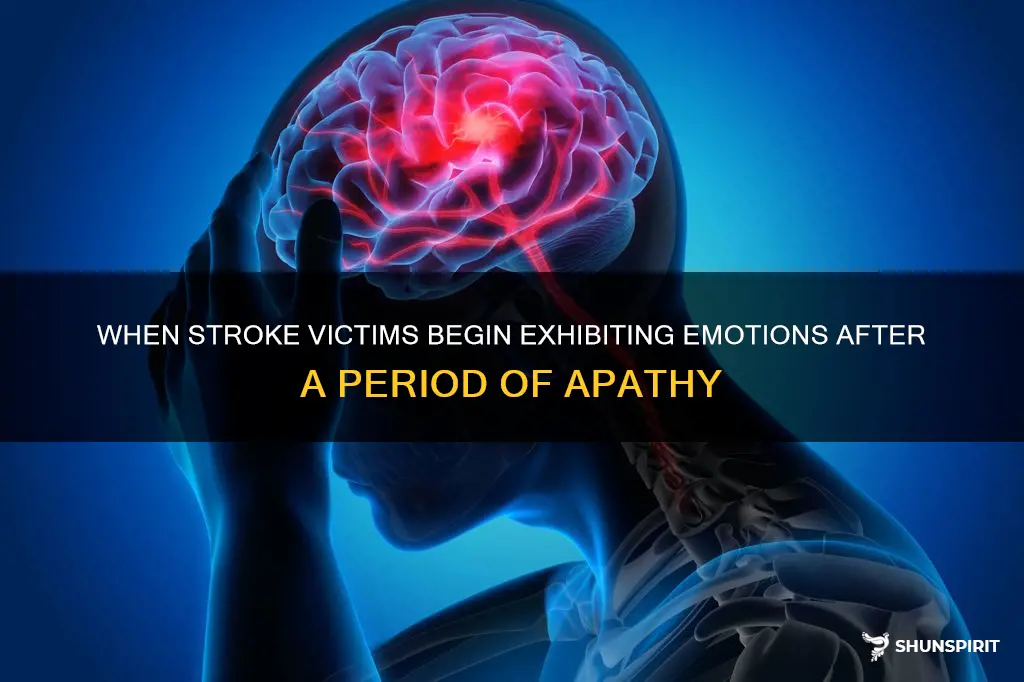
Emotions are the essence of our humanity, allowing us to laugh, cry, and connect with others. But what happens when these emotions are suddenly taken away? For stroke victims, this is a tragic reality, as the damage to their brains often leads to emotional numbness. However, in a remarkable twist, there are cases where these individuals miraculously regain their ability to express emotions. Join me as we explore the fascinating journey of when stroke victims start showing emotions again after being deprived of this fundamental part of their being.
What You'll Learn

Emotional changes after stroke
A stroke is a serious medical condition that occurs when the blood supply to a part of the brain is interrupted or reduced, depriving the brain tissue of oxygen and nutrients. This can result in a variety of physical and cognitive impairments, but what many people may not realize is that strokes can also cause significant emotional changes.
Emotional changes after a stroke can be challenging for both the stroke survivor and their loved ones. Understanding these changes and knowing how to manage them is crucial for a successful recovery and improved quality of life. Here are some common emotional changes that stroke survivors may experience:
- Emotional Lability: Emotional lability, also known as pseudobulbar affect, is a condition characterized by uncontrollable and exaggerated emotional responses. For instance, a stroke survivor may burst into tears or laughter without any apparent reason. These emotional outbursts can be distressing for the individual and may not necessarily reflect their true feelings. Medications, such as antidepressants, can often help manage emotional lability.
- Depression: Depression is a common emotional consequence of stroke. It can make the recovery process even more challenging and hinder overall well-being. Symptoms of depression may include persistent sadness, loss of interest, changes in appetite, difficulty sleeping, and feelings of hopelessness. It is important to seek professional help if you or your loved one are experiencing symptoms of depression after a stroke.
- Anxiety: Anxiety can be another common emotional change after a stroke. A stroke survivor may feel excessively worried, restless, or have a constant sense of impending doom. Anxiety can also manifest physically, with symptoms such as a racing heart, shortness of breath, and trembling. Cognitive-behavioral therapy and medication can be effective in managing anxiety symptoms.
- Emotional Withdrawal: Some stroke survivors may experience emotional withdrawal or a lack of emotion altogether. They may appear indifferent or unresponsive to events or people around them. Emotional withdrawal can be a coping mechanism for the challenges and emotional distress that stroke survivors may face. Encouraging social interaction, engaging in enjoyable activities, and providing emotional support can help a stroke survivor gradually overcome emotional withdrawal.
- Emotional Instability: Stroke survivors may experience emotional instability, with rapid mood swings that can go from happiness to frustration or anger in a matter of seconds. These mood swings can be triggered by even minor events or frustrations. Developing coping strategies, such as deep breathing exercises, practicing mindfulness, and engaging in relaxation techniques, can help manage emotional instability.
It is important to remember that emotional changes after a stroke are a result of the brain injury and the significant life changes that come with it. As a caregiver or loved one, providing support, understanding, and patience is crucial in helping a stroke survivor cope with these emotional changes.
Additionally, seeking professional guidance from a healthcare provider, such as a neurologist or a psychologist, can be highly beneficial. They can provide a comprehensive evaluation and develop a tailored treatment plan to address the emotional changes and facilitate emotional recovery.
In conclusion, emotional changes after a stroke are common and can significantly impact a stroke survivor's quality of life. Understanding and addressing these changes are essential for a successful recovery. By providing support, seeking professional help, and implementing coping strategies, stroke survivors and their loved ones can navigate the emotional challenges after a stroke and work towards emotional well-being.
How to Cultivate Emotional Intelligence for Success in the UPSC Exam
You may want to see also

Re-emerging emotions in stroke patients
After suffering a stroke, many individuals experience a range of physical and psychological changes. One particularly challenging aspect for stroke survivors can be the loss or alteration of emotions. Many stroke patients report feeling disconnected or numb, unable to experience or express their emotions as they once did. However, with time and appropriate care, these emotions can begin to re-emerge.
It is important to note that each stroke survivor is unique, and the recovery process will vary from person to person. However, there are some common steps and strategies that can help facilitate the re-emergence of emotions in stroke patients.
- Seek Professional Help: The first step in addressing emotional changes after a stroke is to consult with a healthcare professional, such as a neurologist, psychiatrist, or psychologist. These professionals can provide an accurate diagnosis, evaluate the extent of emotional changes, and develop a personalized treatment plan.
- Raise Awareness: Stroke survivors should understand that emotional changes are a common occurrence following a stroke. By educating themselves about the potential emotional challenges, individuals can better equip themselves to manage and overcome these difficulties.
- Emotional Regulation Techniques: Learning techniques to regulate emotions can be immensely helpful for stroke patients. Techniques such as deep breathing exercises, progressive muscle relaxation, and mindfulness meditation can promote emotional stability and regulation.
- Therapy: Engaging in therapy sessions, such as cognitive-behavioral therapy (CBT), can help stroke patients address emotional challenges and develop adaptive coping mechanisms. Therapy can provide a supportive environment for individuals to explore their emotions, express themselves, and learn strategies to manage emotional difficulties.
- Encouraging Self-Expression: Family members, friends, and healthcare providers can play a significant role in creating an environment that encourages stroke patients to express their emotions. Providing a safe and non-judgmental space for individuals to share their feelings can help facilitate emotional re-emergence.
- Engage in Activities: Encouraging stroke patients to participate in activities they enjoy can help stimulate emotional responses. Engaging in hobbies, spending time with loved ones, listening to music, or watching emotional movies can all help trigger emotions and promote their re-emergence.
- Patience and Time: Recovery takes time, and the re-emergence of emotions is no exception. It is crucial for stroke patients and their loved ones to be patient and understanding throughout the process. Healing occurs at different rates for everyone, and progress may be gradual.
- Support Networks: Building a strong support network can be vital in facilitating emotional recovery. Connecting with other stroke survivors, joining support groups, or participating in online forums can provide individuals with a sense of belonging and understanding, which can aid in emotional healing.
Ultimately, the re-emergence of emotions in stroke patients is a complex and individualized process. While the journey may be challenging, with the right support, stroke survivors can regain their ability to experience and express their emotions. By seeking professional help, learning emotional regulation techniques, engaging in therapy, and fostering a supportive environment, individuals can take significant steps towards emotional recovery. With patience, time, and determination, stroke patients can reclaim their emotional well-being and lead fulfilling lives.
Navigating Forgiveness: Healing After an Emotional Affair with My Husband
You may want to see also

Impact of stroke on emotional expression
A stroke can have a significant impact on a person's emotional expression. Emotional changes are common after a stroke and can affect a person's ability to communicate and connect with others. It is important to understand the impact of stroke on emotional expression and how to support individuals in regaining their emotional capabilities.
The emotional changes that occur after a stroke can vary from person to person. Some individuals may experience difficulty expressing emotions, while others may have difficulty controlling their emotions. It is not uncommon for stroke survivors to have difficulty displaying facial expressions or speaking with the appropriate tone of voice.
The impact of stroke on emotional expression can be attributed to the damage caused to the brain. Strokes often occur when there is a disruption in blood flow to the brain, leading to the death of brain cells. Depending on the area of the brain affected, emotional expression can be significantly impacted. The areas of the brain involved in emotional expression include the frontal lobe, amygdala, and basal ganglia.
When stroke survivors start showing emotions after a period of not being able to do so, it can be a positive sign of recovery. However, it is important to note that emotional changes can take time and may not occur immediately after a stroke. The brain needs time to heal and rewire itself to regain its previous emotional capabilities.
There are several strategies that can help stroke survivors regain their emotional expression. Speech and language therapy can be beneficial in improving communication skills, including the ability to express emotions. Therapy sessions may involve exercises to strengthen facial muscles and practice expressing a wide range of emotions.
In addition to therapy, it is important to create a supportive and understanding environment for stroke survivors. Encouraging patience and empathy can go a long way in helping individuals feel comfortable expressing their emotions. Family members and caregivers can help by listening attentively, offering reassurance, and providing opportunities for social interaction.
Individuals who are experiencing difficulty expressing emotions after a stroke may also benefit from participating in support groups. These groups provide an opportunity to connect with others who have had similar experiences and can offer guidance and understanding.
It is important to remember that the recovery process from a stroke can be both challenging and unpredictable. Emotional changes may occur gradually, and it is essential to be patient and supportive throughout the journey. Seeking professional help from healthcare providers, such as neurologists or therapists specializing in stroke rehabilitation, can provide valuable guidance and support.
Overall, the impact of stroke on emotional expression can be significant. However, with time, therapy, and support, stroke survivors can regain their emotional capabilities and improve their quality of life. Understanding and compassion from loved ones and healthcare professionals are vital in helping individuals navigate through the emotional challenges following a stroke.
Developing Emotional Intelligence: Tips and Strategies for Cultivating EQ
You may want to see also

Unpredictable emotional responses in stroke survivors
Emotional responses after a stroke can be unpredictable and may vary greatly from one individual to another. It is not uncommon for stroke survivors to experience changes in their emotions, ranging from bouts of uncontrollable crying and laughing to increased irritability and frustration. These emotional responses, collectively named "emotional lability" or "emotional incontinence," can have a significant impact on a stroke survivor's quality of life and relationships.
The timing for when these emotional responses start to appear after a stroke can also differ. Some stroke survivors may begin experiencing emotional lability immediately after the stroke, while others may not exhibit such responses until weeks or even months later. The inconsistency in the timing can make it challenging for caregivers and loved ones to understand and respond appropriately.
The reason behind these emotional responses lies in the damage caused to specific areas of the brain during a stroke. The brain regions involved in regulating emotions, such as the limbic system and frontal lobes, can be affected, leading to a loss of control over one's emotions. Additionally, the loss of communication between different parts of the brain due to stroke-related damage further contributes to the unpredictable emotional responses.
Understanding and managing these emotional responses is crucial for stroke survivors and their caregivers. Here are some strategies that can help:
- Education and awareness: It is essential for both stroke survivors and their caregivers to understand that emotional lability is a common outcome of stroke and not a deliberate behavior. Educating oneself about the condition can help reduce frustration and promote empathy.
- Emotional support: Offering emotional support to stroke survivors is paramount. Validating their feelings and reassuring them that their emotions are a natural response to the stroke can provide comfort and a sense of understanding.
- Seek professional help: Consulting with healthcare professionals, such as doctors, psychologists, or therapists, specializing in stroke rehabilitation can be beneficial. They can provide guidance on managing emotional lability through therapies, counseling, and medication, if necessary.
- Establish a routine: Establishing a structured routine can help provide a sense of stability and control for stroke survivors. Having a predictable schedule can alleviate stress and contribute to emotional stability.
- Encourage healthy coping mechanisms: Encouraging stroke survivors to engage in activities they enjoy and find relaxing can help distract them from overwhelming emotions. This can include hobbies, exercises, or mindfulness techniques like deep breathing or meditation.
- Patience and understanding: Dealing with emotional lability requires patience and understanding from both the survivor and their loved ones. It is crucial to remain calm and not react negatively to outbursts or mood swings. Providing a safe space for expressing emotions can help promote emotional healing.
- Building a support network: Connecting with other stroke survivors and support groups can be helpful for both the survivor and their caregivers. Sharing experiences and learning from others who have gone through similar emotional challenges can provide reassurance and valuable insights.
In conclusion, unpredictable emotional responses in stroke survivors can emerge at various times after a stroke, making it essential for individuals and their caregivers to be prepared. By seeking professional help, fostering understanding, and implementing coping strategies, stroke survivors can effectively manage and navigate through their emotional lability, leading to a better quality of life and improved emotional well-being.
The Importance of Emotional Intelligence in Personal and Professional Success
You may want to see also







